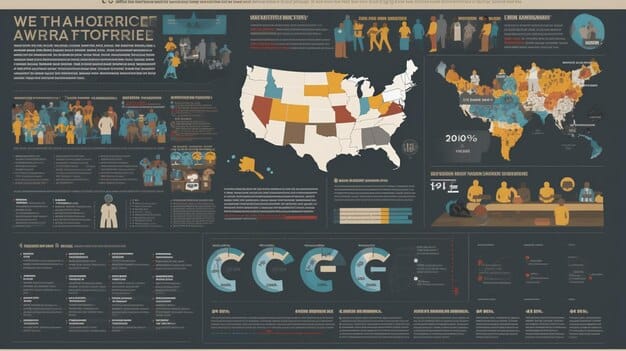Startup News e Trends Article – startup_ne_startupsnewcom_29_1754940784_2a8ff2e8_us_startup.html

The US Startup Ecosystem Report: Which States Are Offering the Most Incentives for New Businesses in 2025? identifies key states proactively implementing robust incentive programs to attract and foster new businesses, essential for navigating competitive entrepreneurial landscapes.
In the dynamic landscape of American entrepreneurship, the question of where to launch a new venture is paramount. Aspiring founders and established innovators alike often seek locations that not only offer fertile ground for growth but also provide tangible support. This quest leads us directly to explore the US Startup Ecosystem Report: Which States Are Offering the Most Incentives for New Businesses in 2025? As we delve into what makes a state truly stand out, we look beyond the obvious hubs to uncover emerging powerhouses and sustained leaders in fostering a vibrant startup culture.
Understanding the Landscape of Startup Incentives in 2025
The competitive nature of startup development has driven many US states to implement sophisticated incentive programs. These initiatives are not merely about tax breaks; they encompass a wide array of support mechanisms designed to attract and retain entrepreneurial talent. From direct financial grants to robust mentorship networks, states are vying to become the next Silicon Valley, or at the very least, a significant player in specific tech sectors.
The year 2025 marks a pivotal moment, as economic shifts and technological advancements redefine what constitutes a valuable incentive. States that have historically relied on broad-stroke policies are now refining their approaches, targeting specific industries like AI, biotech, or clean energy, leveraging their unique regional strengths. This strategic focus enhances the effectiveness of their programs, ensuring that resources are allocated efficiently to foster high-growth potential businesses.
The Shift Towards Targeted Incentives
Gone are the days when a general tax incentive was enough to lure a startup. Today, states are engaging in a much more nuanced battle for entrepreneurial talent. This involves not only financial incentives but also the cultivation of supportive infrastructures, such as specialized incubators and accelerators. Moreover, the availability of a skilled workforce and access to top-tier research institutions are increasingly becoming deciding factors for founders.
- Sector-Specific Grants: Funding tailored for emerging industries like quantum computing or sustainable agriculture.
- Access to Venture Capital Networks: State-sponsored programs connecting startups with angel investors and venture capital firms.
- Talent Development Initiatives: Partnerships with universities and vocational schools to ensure a steady supply of skilled labor.
- Regulatory Sandboxes: Environments allowing new businesses to test innovative products or services under relaxed regulatory oversight.
This strategic shift reflects a deeper understanding of the startup lifecycle. States realize that initial funding is just one piece of the puzzle. Sustained growth requires continuous access to capital, talent, and a regulatory environment that encourages innovation rather than stifling it. Incentives are increasingly designed to foster long-term relationships, building loyalty and encouraging companies to scale within the state’s borders.
Furthermore, the focus has expanded to include incentives that address quality of life issues, recognizing that founders and their employees are attracted to states that offer more than just business opportunities. Affordable housing, excellent schools, and vibrant cultural scenes are now considered integral components of a competitive startup ecosystem. This holistic approach ensures that states are not just attracting businesses, but also building sustainable communities around innovation.
Key States Leading the Charge in Startup Incentives for 2025
Several states consistently appear at the forefront of fostering new business growth, due to their innovative and comprehensive incentive packages. While some are long-standing leaders, others are rapidly gaining ground by implementing cutting-edge strategies. Their success lies in a multi-faceted approach that addresses the diverse needs of modern startups, from initial seed funding to scaling operations.
Among the top contenders, states like Massachusetts and California continue to leverage their existing strong academic and technological infrastructures. However, their incentive structures are evolving to combat high living costs and intense competition, focusing on highly specialized niches and encouraging geographic diversification within their own borders. For example, California’s initiatives are increasingly moving beyond Silicon Valley, promoting growth in areas like San Diego (biotech) and Los Angeles (entertainment tech).
Emerging Hubs and Their Differentiating Factors
Beyond the traditional hubs, a new generation of states is making significant strides. These emerging players often offer lower operating costs, a burgeoning talent pool, and a highly collaborative environment. Their appeal lies in providing a fresh perspective on what a supportive startup ecosystem can be, often with a commitment to specific industries.
- Texas: Renowned for its friendly business environment, no state income tax, and a rapidly growing tech sector, particularly in Austin. Incentives include programs like the Texas Enterprise Fund for job creation.
- Florida: Attracting tech companies with its favorable tax policies, growing tech hubs in Miami and Orlando, and initiatives promoting innovation in sectors like fintech and space exploration.
- North Carolina: Leveraging its Research Triangle Park, this state offers strong university partnerships, a skilled workforce, and targeted grants for biotech and advanced manufacturing.
- Utah: Known as “Silicon Slopes,” Utah provides a supportive community, relatively low operating costs, and tax credits for R&D and digital media projects.
Arizona, for example, has significantly invested in its semiconductor industry, offering substantial tax credits and workforce development programs to attract and grow businesses in this critical sector. Similarly, Ohio has focused on attracting advanced manufacturing and data analytics firms, providing grants and loans for companies that commit to job creation and capital investment. These states understand that niche specialization can be a powerful differentiator in a crowded market, drawing in specific types of innovative companies.
Furthermore, states are keenly aware of the importance of robust digital infrastructure. Investment in high-speed internet across rural and urban areas is becoming a core incentive, enabling remote work and distributed teams, which is increasingly vital for modern startups. The blend of financial, infrastructural, and quality-of-life incentives creates a compelling package for entrepreneurs looking to establish and expand their businesses.

Financial Incentives: Grants, Tax Credits, and Loans
Financial incentives remain a cornerstone of state strategies to attract and nurture startups. These can range from direct cash infusions through grants to indirect support via tax credits and low-interest loans. The effectiveness of these programs often depends on their accessibility and alignment with the specific growth stages of new businesses, from ideation to market scaling.
Grants, often non-dilutive, are highly attractive to early-stage startups as they provide capital without founders having to give up equity. Many states offer grants tied to specific outcomes, such as job creation in underserved communities, development of intellectual property, or significant capital investment. These grants can be competitive but offer a substantial boost to a startup’s initial trajectory, enabling critical R&D or pilot programs.
Types of Financial Support Available
Tax credits are another powerful tool, reducing a company’s tax burden and freeing up capital for reinvestment. These can include credits for research and development, investment in qualified property, or hiring specific types of employees. For instance, some states offer credits for creating high-paying jobs in technology or for investing in renewable energy projects. Loans, often at preferential rates or with deferred repayment options, bridge funding gaps and facilitate expansion.
- Research and Development (R&D) Tax Credits: Incentives for companies conducting R&D within state borders, reducing taxable income.
- Job Creation Tax Credits: Credits awarded for creating new full-time jobs, particularly in high-growth or distressed areas.
- Angel Investor Tax Credits: Incentives for individuals who invest in qualifying early-stage businesses within the state.
- Seed and Early-Stage Matching Funds: State programs that match private investment in promising startups.
Beyond traditional financial instruments, some states are innovating with programs like “equity equivalent investments,” which provide capital in exchange for a future equity stake, but with terms that are more favorable to the startup than traditional venture capital. This blend of financial tools allows states to cater to a broader spectrum of startup needs, from those needing quick capital for product development to those seeking long-term funding for market penetration.
Moreover, the transparency and ease of application for these financial incentives are becoming increasingly important. States that streamline their application processes and provide clear guidelines tend to see higher engagement from startups. This administrative efficiency is itself an incentive, reducing the bureaucratic burden on founders who are already juggling multiple responsibilities.
Non-Financial Support: Accelerators, Mentorship, and Infrastructure
The success of a startup ecosystem extends far beyond financial aid. Non-financial support mechanisms play a crucial role in providing the knowledge, connections, and environment necessary for new businesses to thrive. These resources foster innovation, build resilience, and connect founders with invaluable expertise and networks.
Accelerators and incubators are at the forefront of this non-financial support. These programs provide structured environments, often with dedicated office space, shared resources, and intensive training tailored to the needs of early-stage companies. They offer critical guidance on business model validation, product development, fundraising strategies, and market entry, significantly increasing a startup’s chances of success.
Building a Supportive Network
Mentorship programs, often integrated within accelerators or offered independently by state economic development agencies, connect inexperienced founders with seasoned entrepreneurs and industry experts. These mentors provide practical advice, share lessons learned, and open doors to crucial business contacts. The value of an experienced guide who can navigate the complexities of startup growth cannot be overstated.
- Startup Accelerators: Programs offering mentorship, resources, and often seed funding in exchange for equity.
- Business Incubators: Environments supporting early-stage companies with shared office space, equipment, and administrative services.
- Mentorship Networks: Programs connecting aspiring entrepreneurs with experienced business leaders and specialists.
- Co-working Spaces: Affordable and collaborative environments that foster networking and idea exchange among startups.
Furthermore, access to top-tier research institutions and university partnerships is a powerful non-financial incentive. These collaborations allow startups to leverage cutting-edge research, access specialized laboratories, and tap into a pipeline of highly skilled graduates. States with strong university systems often see a higher rate of spin-outs and technology transfer, fueling their local innovation economies.
The provision of robust digital infrastructure, including high-speed broadband and resilient cybersecurity frameworks, is also becoming a key non-financial incentive. In an increasingly digital economy, reliable connectivity is foundational for any modern business. States that prioritize these infrastructural improvements ensure that their startups are not hampered by technological limitations, regardless of their physical location within the state.
Sector-Specific Approaches and Future Trends
As the US startup ecosystem matures, states are increasingly adopting sector-specific strategies to maximize their competitive advantages. Rather than broad-brush incentives, many are now focusing on cultivating particular industries where they have existing strengths, whether in terms of talent, research, or natural resources. This targeted approach allows for more effective deployment of resources and builds deeper expertise within specific verticals.
For example, states with strong agricultural roots might focus on agritech incentives, developing programs that support innovations in sustainable farming, precision agriculture, or food processing technologies. Similarly, states with significant healthcare systems often prioritize biotech and medical device startups, offering specialized grants, regulatory guidance, and access to clinical trials. This specialization creates concentrated hubs of excellence that attract further investment and talent.
Emerging Sectors and Policy Innovation
Looking ahead to 2025 and beyond, several key trends are likely to shape state incentive policies. The rise of artificial intelligence, sustainable technologies, and advanced manufacturing will continue to redefine the landscape. States that can quickly adapt their incentive structures to these emerging fields will gain a significant competitive edge.
- AI and Machine Learning: Incentives for companies developing AI solutions, leveraging state universities and research labs.
- Clean Energy and Sustainability: Grants, tax credits, and regulatory support for renewable energy, cleantech, and sustainable practices.
- Biotechnology and Life Sciences: Focused funding and infrastructure for drug discovery, medical devices, and health tech.
- Advanced Manufacturing: Support for companies utilizing robotics, automation, and 3D printing.
Another crucial trend is the increasing emphasis on diversity, equity, and inclusion (DEI) within the startup ecosystem. States are recognizing the economic and social benefits of supporting a wider range of founders, including women, minorities, and entrepreneurs from underserved communities. Incentive programs are being designed to address historical funding disparities and provide specialized support for these groups, fostering a more inclusive and dynamic startup landscape.
Finally, the growing importance of “soft infrastructure”—such as a thriving cultural scene, affordable housing, and excellent public services—is becoming an implicit incentive. States that invest in these areas create a more attractive overall environment for founders and their employees, making their incentive packages even more compelling. The future of startup incentives will be less about isolated programs and more about creating holistic, supportive ecosystems.

Challenges and Opportunities in Optimizing State Incentives
Despite the significant efforts by US states to foster their startup ecosystems, numerous challenges persist. These include intense interstate competition, the difficulty of accurately measuring the long-term impact of incentives, and the need to adapt to rapidly changing technological and economic landscapes. Overcoming these hurdles requires continuous evaluation and strategic recalibration of policies.
One major challenge is the “race to the bottom” phenomenon, where states might offer increasingly generous incentives, potentially at the expense of other public services, to attract high-profile companies. This can lead to unsustainable fiscal policies if not managed carefully. The opportunity lies in creating unique value propositions that go beyond mere financial inducements, focusing on niche strengths and quality of life.
Ensuring Long-Term Impact and Adaptability
Another challenge is ensuring that incentives genuinely lead to sustainable job creation and economic growth, rather than temporary boosts. This requires robust metrics and longitudinal studies to track the performance of companies that receive state support. Transparency and accountability in how public funds are deployed are paramount to maintaining public trust and ensuring program effectiveness.
- Measuring ROI Effectively: Developing clear metrics to assess the return on investment for incentive programs.
- Avoiding “Incentive Shopping”: Designing programs that attract long-term commitments rather than companies seeking quick benefits.
- Adapting to Economic Shifts: Flexibility in policies to respond to recessions, new technologies, and global market changes.
- Balancing Local Needs with State Goals: Ensuring incentives benefit local communities while serving broader state economic objectives.
The rapid pace of technological change presents both a challenge and an opportunity. States must be agile enough to recognize emerging industries and adapt their incentive programs accordingly. This proactive approach ensures that their ecosystems remain relevant and competitive. For instance, incentives designed for the dot-com era might be obsolete for AI-driven startups, necessitating frequent updates to policy frameworks.
Furthermore, internal state dynamics, such as political changes or shifts in budget priorities, can impact the consistency and longevity of incentive programs. Opportunities lie in building bipartisan support for long-term economic development strategies, transcending short-term political cycles. Collaborative efforts between state agencies, universities, and private industry can create a resilient framework that withstands political fluctuations and sustains innovation over time.
Ultimately, the effectiveness of state incentives hinges on their ability to create a truly integrated and supportive environment for startups, addressing not just financial needs but also infrastructural, talent, and quality-of-life considerations. The states that embrace this holistic view will be the ones that truly thrive in the competitive landscape of 2025 and beyond.
| Key Incentive | Brief Description |
|---|---|
| 💰 Financial Aid | Includes grants, tax credits (R&D, job creation), and low-interest loans to boost startup capital. |
| 💡 Non-Financial Support | Access to accelerators, incubators, mentorship networks, and co-working spaces for operational and strategic guidance. |
| 📈 Sector-Specific Focus | Tailored programs for industries like AI, biotech, clean energy, and advanced manufacturing to maximize regional strengths. |
| 🌐 Infrastructure & Talent | Investment in high-speed internet, university partnerships, and workforce training to ensure skilled labor and connectivity. |
Frequently Asked Questions About US Startup Incentives
States offer a mix of financial incentives, such as grants, various tax credits (R&D, job creation), and favorable loans. Non-financial support includes access to startup accelerators, incubators, mentorship programs, networking events, and co-working spaces. Many states also invest heavily in public infrastructure and university partnerships.
While California and Massachusetts remain strong, emerging leaders in comprehensive incentives for 2025 include Texas, Florida, North Carolina, and Utah. These states are recognized for their robust financial aid, supportive ecosystems, and often, sector-specific programs tailored to their regional economic strengths and emerging industries.
States identify their unique economic strengths or strategic growth areas. For biotech, they might offer specialized R&D grants, access to university labs, or regulatory sandboxes. For AI, incentives could include data science talent development programs, funding for AI research partnerships, and favorable tax conditions for AI-focused companies, leveraging local expertise.
Beyond money, crucial non-financial factors include a vibrant community of entrepreneurs, strong mentorship networks, access to skilled talent pools from universities, high-quality digital infrastructure, and a supportive regulatory environment. Quality of life, including affordable living costs and cultural amenities, also plays a significant role in attracting and retaining founders and employees.
Startups should research states that align with their industry, consider operating costs, assess the availability of specialized talent, and evaluate the breadth of both financial and non-financial support. Networking within relevant state entrepreneurial communities and consulting with economic development agencies can also provide invaluable insights.
Conclusion
The landscape of US startup incentives in 2025 is a complex yet opportune environment for new businesses. States are increasingly sophisticated in their approaches, moving beyond simple tax breaks to offer comprehensive ecosystems that foster innovation, provide tailored financial support, and build robust networks. For founders, understanding these nuanced offerings is crucial for strategically positioning their ventures for long-term success. The states that will truly stand out are those that not only offer compelling incentives but also cultivate an enduring culture of support, adaptability, and forward-thinking policy, ensuring a vibrant future for American entrepreneurship.





